Foundation Repair
Our main business is installing deep-drilled, steel-reinforced, poured in place concrete piers under the center of the perimeter of the footing to raise the foundation and prevent future settlement.
CAUSES OF FOUNDATION SETTLEMENT
Probably the most common cause of foundation failure is due to the type of soil on which the structure is built – expansive clay. Characteristically, clay expands as it absorbs moisture and shrinks as it dries. When clay expands, it causes an uplifting motion. When it contracts or shrinks, it has a settling affect. The movement caused by these changes is passed on to the foundation causing it to settle and eventually crack. Depth of any type pier or underpin is critical in the repair of settlement due to expansive clay. The pier must bear below the shrink/swell area of soil where the moisture content of the soil is stable. Geotechnical engineers state this is about 8' deep but in our experience we still find this depth very dry during drought conditions.
A home constructed on poorly compacted fill material can have similar problems but typically does not go through the swelling process. The amount of fill and type of fill material used will compress over a period of time. As the materials compress, the foundation or slab settles and causes damage to the structure. This is more common on monolithic slab homes that require a level area to build on.
On mountainside lots, part of the foundation often bears on rock that doesn’t move and part of the foundation bears on fill or natural clay soil that shrinks as stated above. The city of Huntsville changed the code for building on slopes in 1992 and has eliminated this settlement problem for these homes built after 1992.
SIGNS OF FOUNDATION PROBLEMS
EXTERIOR
- Cracks in the brick, normally at corners of windows and doors
- Separation between the brick and sides of doors or windows
- Separation of the wood frieze board or trim at the top of the brick at the corners of the house
- Other vertical or stairstep cracks in the brick
INTERIOR
- Cracks in the sheetrock around windows or doors
- Doors sticking or out of square
- Humps/dips in floor
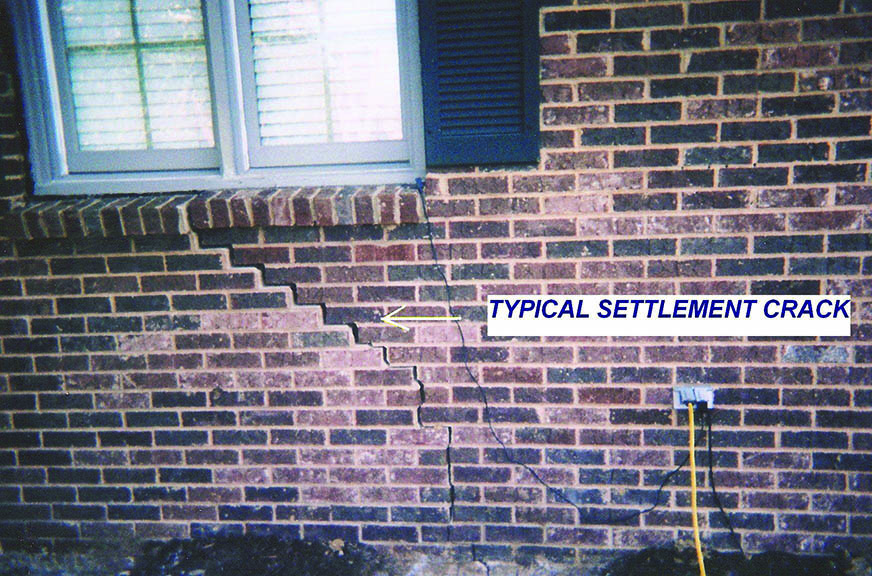
ABOUT OUR REPAIR PROCESS
DEEP DRILLED PIERS
This is the oldest proven method of foundation repair but the most time consuming. These drilled piers are the only method used in new construction of commercial buildings, parking garages and overpasses. Our piers are only a scaled down version to support the load of the house. Drilled piers are installed on homes at construction in some areas of the country.
Other easier methods of foundation repair have been developed over the last 20 to 30 years but none compare to the drilled piers. We have tried some of these methods in the past but encountered problems and decided we couldn’t stand behind them.
ADVANTAGES OF DEEP DRILLED PIERS
1) We know what we bear on! If shallow rock is encountered, a 1½" hole is drilled 2' into the rock to verify it is not a thin layer of rock. Our equipment will also drill through tree roots and small rock layers. Other methods will stop when they encounter objects below ground. We space our piers 5' to 6' apart, which is the maximum recommended by structural engineers, considering most homes with foundation problems have minimal footings and no rebar reinforcements. Any farther spacing and the footing may break between the piers and leveling is restricted. The bearing area on rock is the full 12" diameter of the pier and we can see the bottom of the pier shaft and the rock. If rock is not encountered at a depth of 12' to 14', or deeper if required, the bottom of the pier shaft is enlarged to 30" with a belling tool.
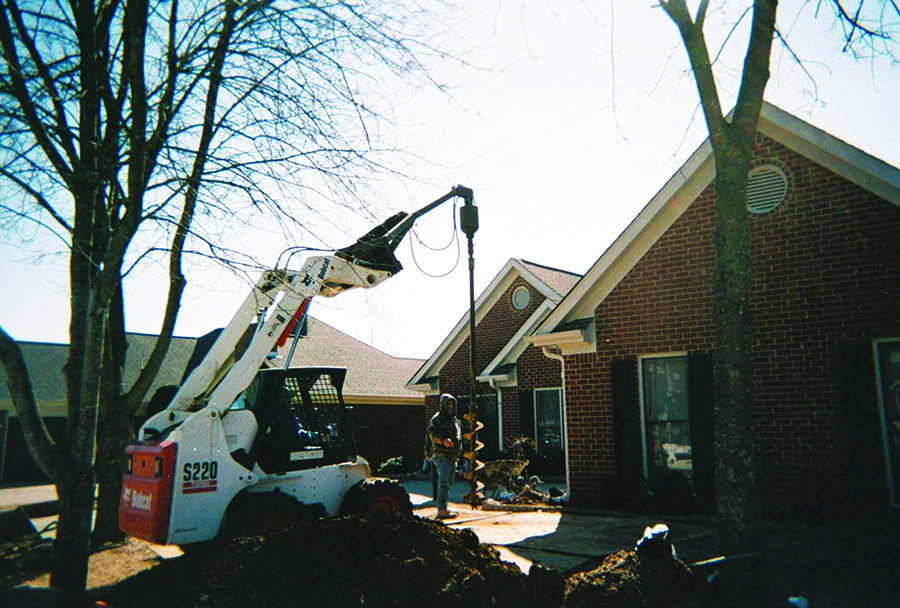
2. On rocky mountainside lots, we normally spend more time with a jackhammer than drilling equipment. Chunk rock or layered rock is removed with the jackhammer until good rock is encountered and verified as stated in #1 above. The new concrete piers are doweled to the rock with rebar to prevent slide of the piers on the rock.
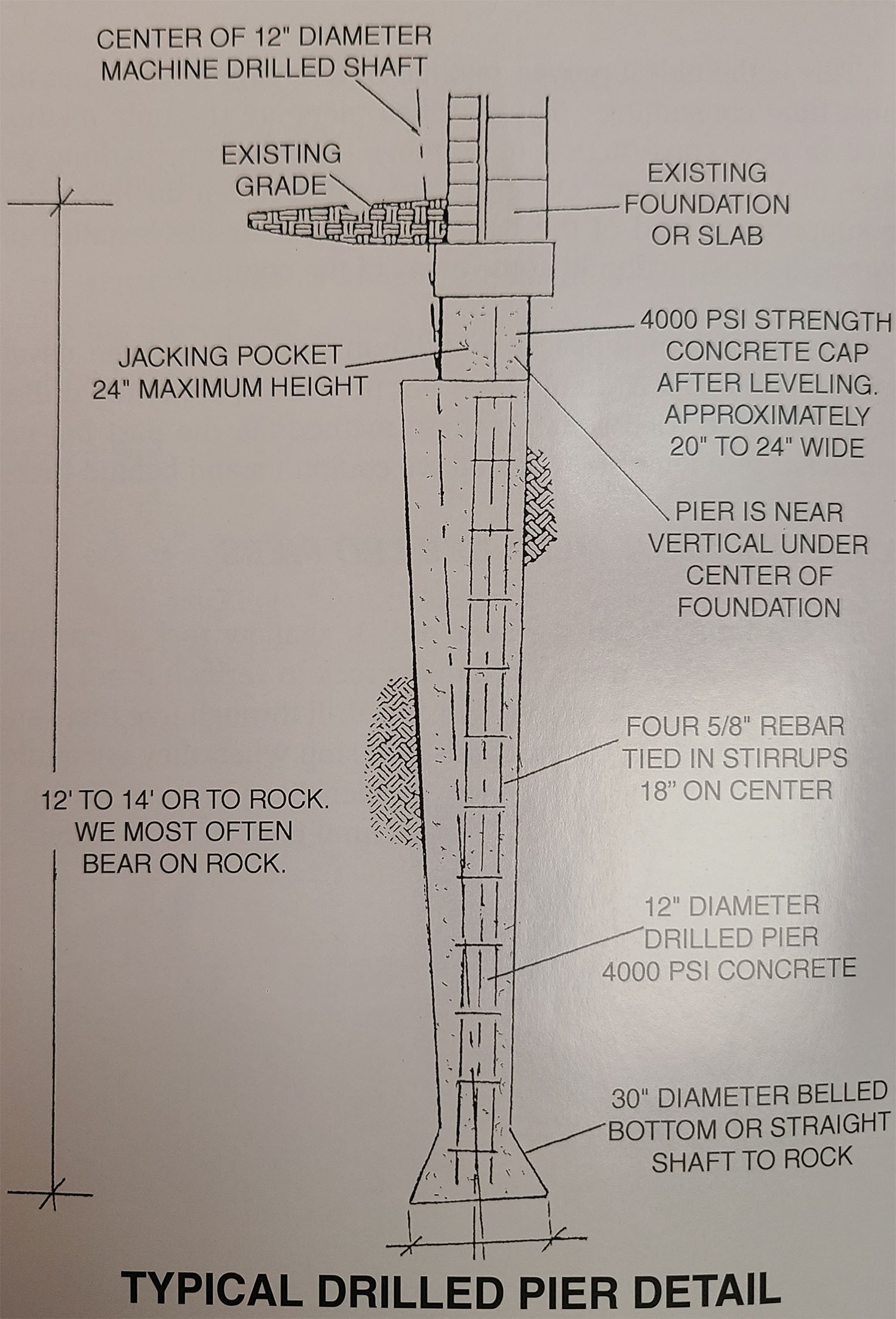
3. The 12" diameter pier shaft is filled with 4000 psi concrete, steel reinforced with four vertical 5/8" rebar the depth of the pier shaft.
4. The center of the pier shaft is placed under the center of the foundation, not on the outside of the footing supporting a metal bracket that extends under the footing as some methods are.
5. The bearing of the footing at each pier location is approximately 20" to 24" rather than 6" to 12" with other methods. The poured concrete cap between the new pier and footing supports the existing footing continuously and forms to the irregular bottom of the footing.
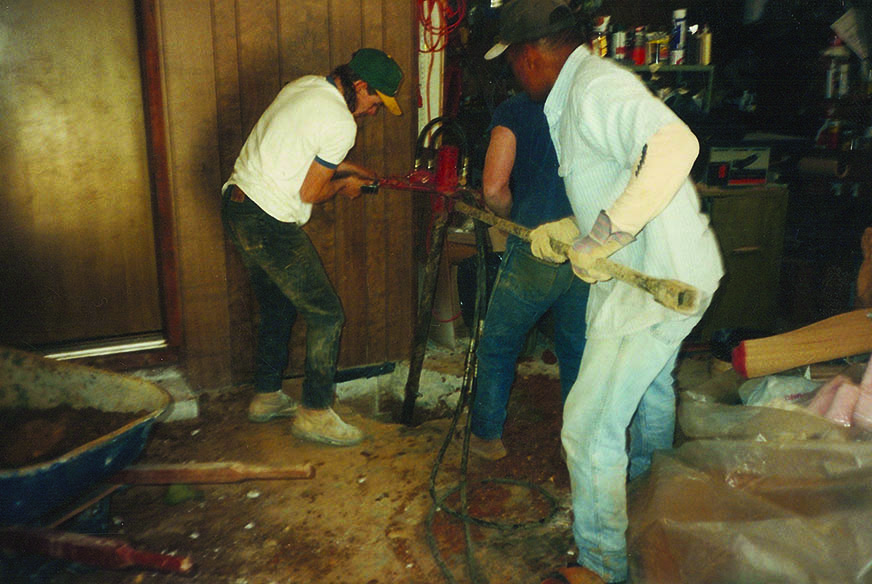
6. Concrete is forever and never stops getting stronger. Concrete does not rust.
7. We are very successful during the leveling process since we use 20 ton hydraulic jacks at each pier location to raise the structure. Each jack is raised at a different rate to raise the area evenly.
PRESSURE GROUTING / SLABJACKING
This process is used to raise the interior slab of the home or garage that has settled. A thin cement grout is pumped through 2" holes drilled in the slab and the slab basically floats back up. This process is also used after leveling the exterior of a slab home with drilled piers if a void is created under the interior slab during the leveling of the exterior. Driveways and pool decks can also be raised with this process but is not always cost effective.
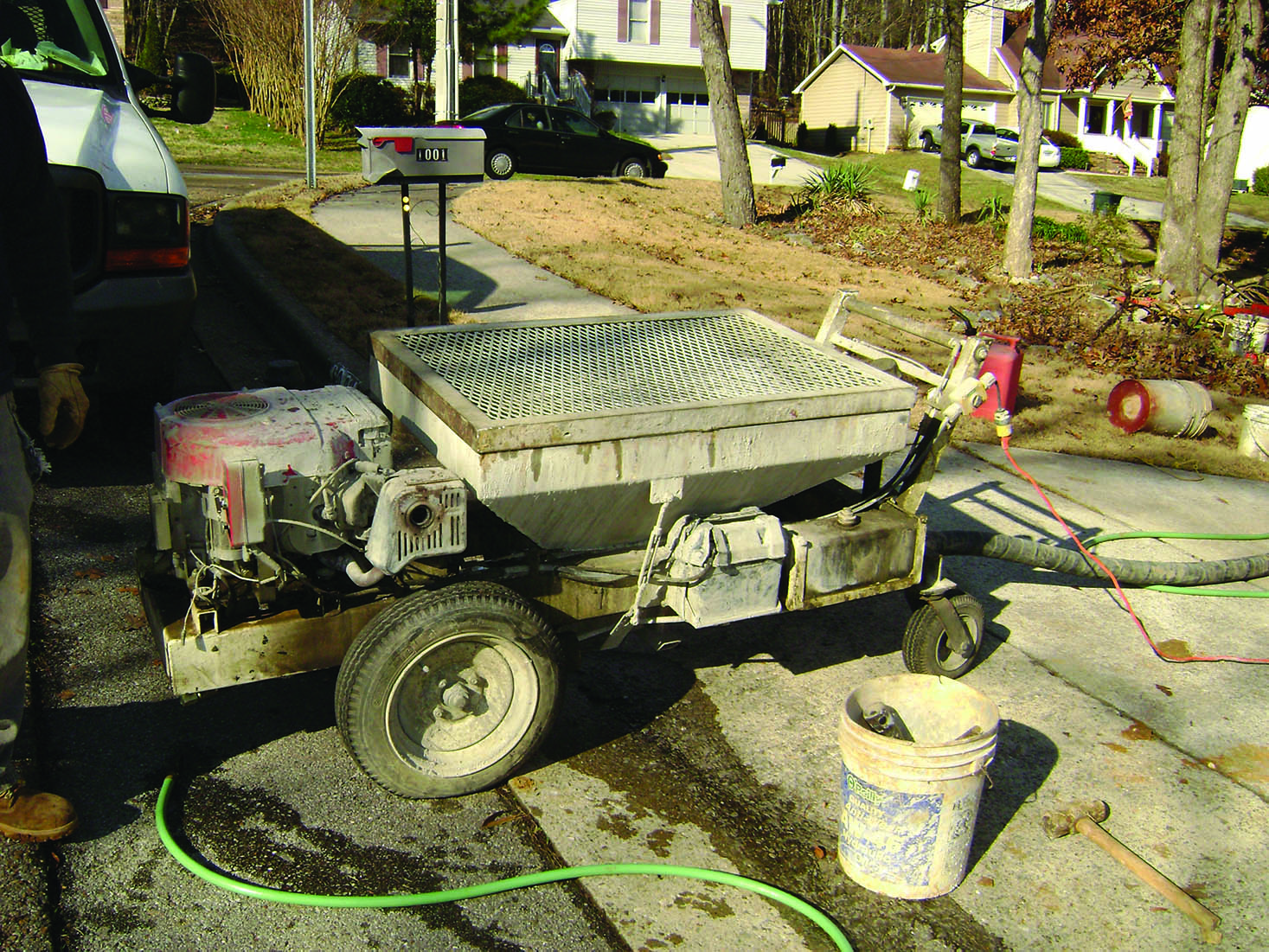
PIERS AND BEAMS IN CRAWL SPACE
These are normally required when walls bear on long floor joist spans causing the joist to deflect or sag. The concrete footings for these piers are 24" x 24" x 12" to 18"deep with rebar reinforcement. Our piers can be spaced up to 8' apart since our beams that support the joist are triple 2 x 10 or 2 x 12. After leveling, 3½" steel columns with 6" x 8" x ½" steel top and bottom plates are fabricated the exact length required to support the beam to the piers. Other companies’ columns use adjustable top plates that are about 3" x 3" x 1/8" to ¼" thick supporting 4 x 6 pressuretreated beams which will shrink. Our steel columns do not have adjustable bolts and look permanent. These piers and beams are also used for bounce and vibration in long floor joist spans.
BASEMENT / RETAINING WALL FAILURE
Leaning retaining walls and inward bulges in basement walls are very common problems on older hillside homes. These basement walls are not filled with concrete and are backfilled with total soil which self-compacts over years and pushes on the walls. This is aggravated by water that adds pressure to the soil or expands the soil. The type of repair depends on the severity of the bulge in the wall. There are four different repairs we recommend depending on the amount of inward bulge. For minor bulges, only filling the wall with concrete is normally recommended. In the worst case, replacement of the wall is recommended.
Normally, replacement of leaning retaining walls is recommended although we have stabilized some, but they cannot be straightened.
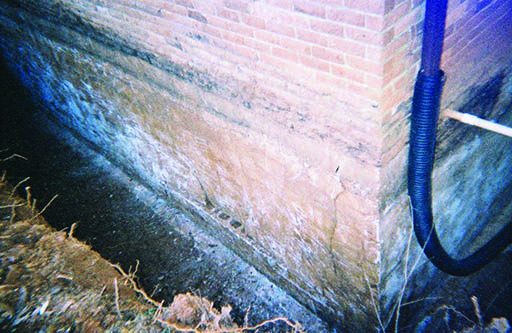
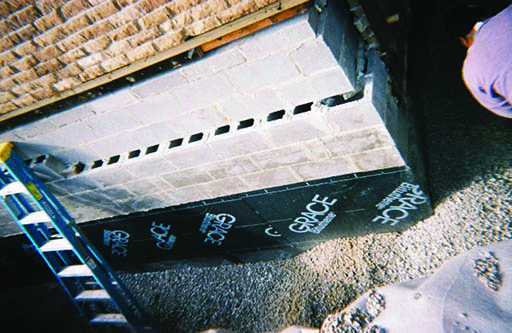
THE FINAL STEP - CLEANUP
We have always taken pride on having a yard as good as or better than it was when we started. This probably accounts for the most compliments we get. On completion, the area is graded, topsoil added if required, shrubs replanted if removed and new mulch placed in the beds around the home if disturbed. Lawn areas are seeded and strawed. All concrete surfaces and pressure washed.
FOR YOUR PROTECTION
Building permits are required for any foundation repair in the city of Huntsville and most other cities require the contractor to obtain one. If your contractor asks you to get the permit, they do not have a license. A new ordinance in the city of Huntsville requires any home in a designated slope area to have a structural engineer approval of the design before a permit will be issued. We have an engineer we work with on these approvals which usually costs between $200 and $300 for inspection of the home and his seal on our repair plan with a letter to the city.
Before an agreement is reached with any company to repair your foundation, check with previous customers concerning the company’s reliability and service. Play it safe and call the Better Business Bureau. The eventual decision of which contractor to use should be based on cost of repair, past service record, methods of repair and reputation of the company. Check the guarantee provided by other contractors and determine when a guarantee will be voided, such as thickness of footing or lack of steel reinforcement in the footing. Most homes built before 1980 do not have steel reinforced footings. Be very cautious of any contractor that requires a deposit or any money when starting. They may not be financially stable. We never require any money when we start and normally require full payment on completion. On large jobs costing approximately $15,000.00 or more, we may require partial payment about half way through the job. Look at our deep-drilled, concrete piers and other repair methods. Which method would support your home better, forever? It’s obvious that’s why we haven’t changed to one of the easier repair methods.
Remember – lowest price isn’t always the best choice.